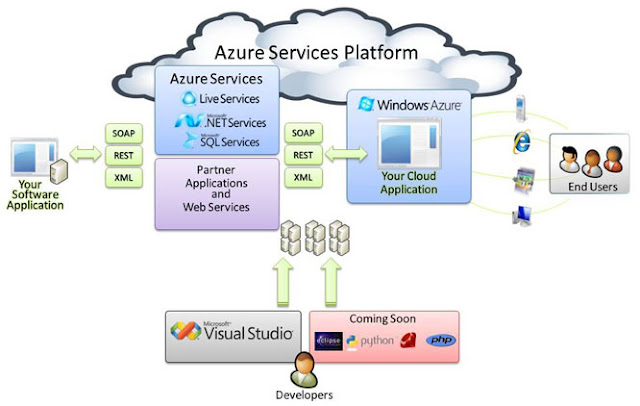The Future Is In The Clouds: Microsoft Launches Cloud Services Website
Why do i say that Office 2010 is the beginning of the cloud era? Well, some of the applications in Office 2010 is developed with cloud computing in mind...for example, Microsoft Office Live Meeting and Office Communications Online.The website also have a Silverlight-powered video where Microsoft CEO Steve Ballmer talks about how he thinks cloud is the future path for Microsoft's development and how cloud provides an opportunities for Microsoft to improve and stay ahead of technology rivals such as Google. Better toggle off the video though, if you're sick of Ballmer's speech (LOL). Well if you notice carefully enough, you'll notice that cloud-based services from Microsoft is slowly taking shape as of today; see below image for reference:
Microsoft's Cloud Service is powered by a service platform known as the Azure Services Platform. Within the Azure Service Platform, a cloud operating system called Windows Azure will be the acting medium for applications's operation such as Office Live, SharePoint Services etc.
Visit the new Cloud Services website and see for yourself: Microsoft officially lists six software categories as the firsts to be hosted in the cloud, though i'm convinced with the progress of services infrastructures and developments, more services will be added to the current list in the future:
1. Windows
Development of Windows Azure, Microsoft's first ever cloud-based OS, is first mentioned in the 2008 PDC Conference by Ray Ozzie. Windows Azure supports cloud computing in a sense that it serves as a platform for in-the-cloud applications to run together as a bundle of internet services which is accessible from the on-premises environment and the Internet itself.
Meanwhile, Windows Live ID (your Hotmail/Live ID which incorporates your username and password) will be sort of like your online identification card on which Microsoft requires to provide services to you. This indirectly means that your Windows Live ID is starting from today, something which importance is as high as your IC and your Passport.
2. SQL (Structured Query Language) Servers
SQL databases used to be created & managed with the help of physically-hosted ERP software or Database Management System (DBMS) such as SAP, Oracles and at the simplest, Microsoft Office Access. Since Windows Azure provides the ability to host SQL database online, database managers now don't have to create, setup, manage or patch their database anymore.
3. Exchange
Microsoft Exchange is the predominant mail client of Microsoft way back during the popularities of Windows 95 and 98 until it was replaced by Microsoft Office Outlook.Meanwhile, Microsoft Exchange Server survives and thrives until now, where it is often used by enterprise as infrastructure providers in Windows Server 2003 & 2008. With cloud computing, Exchange is now brought to the cloud and run as an in-the-cloud services.
4. SharePoint
Microsoft SharePoint also goes to the cloud now, giving business employees the power to share information and data online from anywhere, at anytime and not forsaking the idea of being able to collaborate with each other as usual. Going to the cloud means that SharePoint is now more secure and more centralized in terms of management.
5. Office
Office Live Meeting, Office Communications Online and Office Web Apps also goes into the cloud. Starting with the latest Microsoft Office 2010, users can now host real-time conference online, real-time communications with text, voice and videos, plus the ability to now access and edit your Office-based documents (eg, your Word, Excel and Access) anywhere.
6. Dynamics CRM (Customer Relationship Management)
Previous CRM management means that information managers have to keep track of customer information & relations with the aids of either separate or integrated applications, meaning that costs will be high and CRM systems are constantly bugged with planning, implementation and adoption issues. With Microsoft Dynamics CRM now in the cloud, CRM can be centrally managed through an integrated system online, saving business organizations the troubles of having to develop, implement and manage the CRM systems themselves. The only concern left is getting clients to adopt to them!
Microsoft also clearly states that the new cloud services provided will be useful for technical professionals business professionals and government and educational sectors. For technical professionals, they can now utilize all the provided applications to enhance, create new and manage their current information systems when they are trying to develop an IT infrastructure that meets business needs. All they need to focus now is on producing quality codes and defining business needs. For business professionals and government & education, they've been provided with a complete set of online applications to manage their business information online; without the need to even change or implement new services anymore!
Sources suggest that a huge majority of Microsoft employees are now working on cloud development, and we are talking about a majority of the 93000 employees at Microsoft, which is a ridiculously huge number. Honestly, if Microsoft are really so dedicated that they could reduce attention on developing host-based software like Windows 8, then they must really be serious about things. Bring on the cloud, then!









0 opinion:
Post a Comment